Sources of Law, Law-Making, and Impact on Business: A Detailed Report
VerifiedAdded on 2023/06/13
|10
|4010
|220
Report
AI Summary
This report provides a comprehensive overview of business law, covering various sources of law such as common law and statutory law, the process of law-making by the government, and the applicability of these laws in the court of justice. It describes the impact of employment, contract, and company law on businesses, highlighting the importance of compliance and the potential consequences of non-compliance. Furthermore, it outlines different types of business forms or structures, including sole proprietorships and partnerships, and discusses how these forms are managed and funded. The report concludes by offering legal solutions and recommendations applicable to resolving a range of disputes, emphasizing the need for businesses to adhere to legal frameworks for effective and ethical operations. Desklib offers a range of resources including past papers and solved assignments for students.
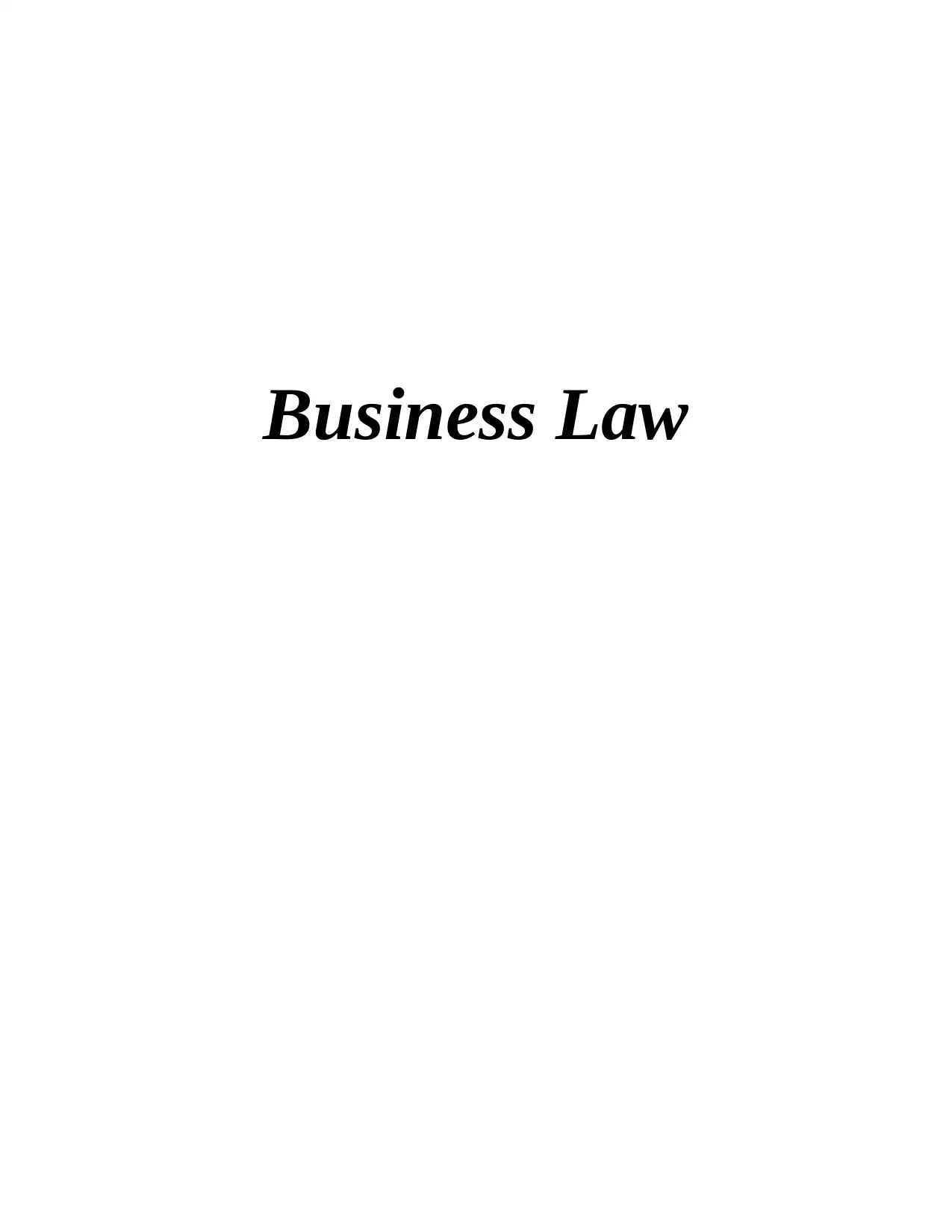
Business Law
Paraphrase This Document
Need a fresh take? Get an instant paraphrase of this document with our AI Paraphraser
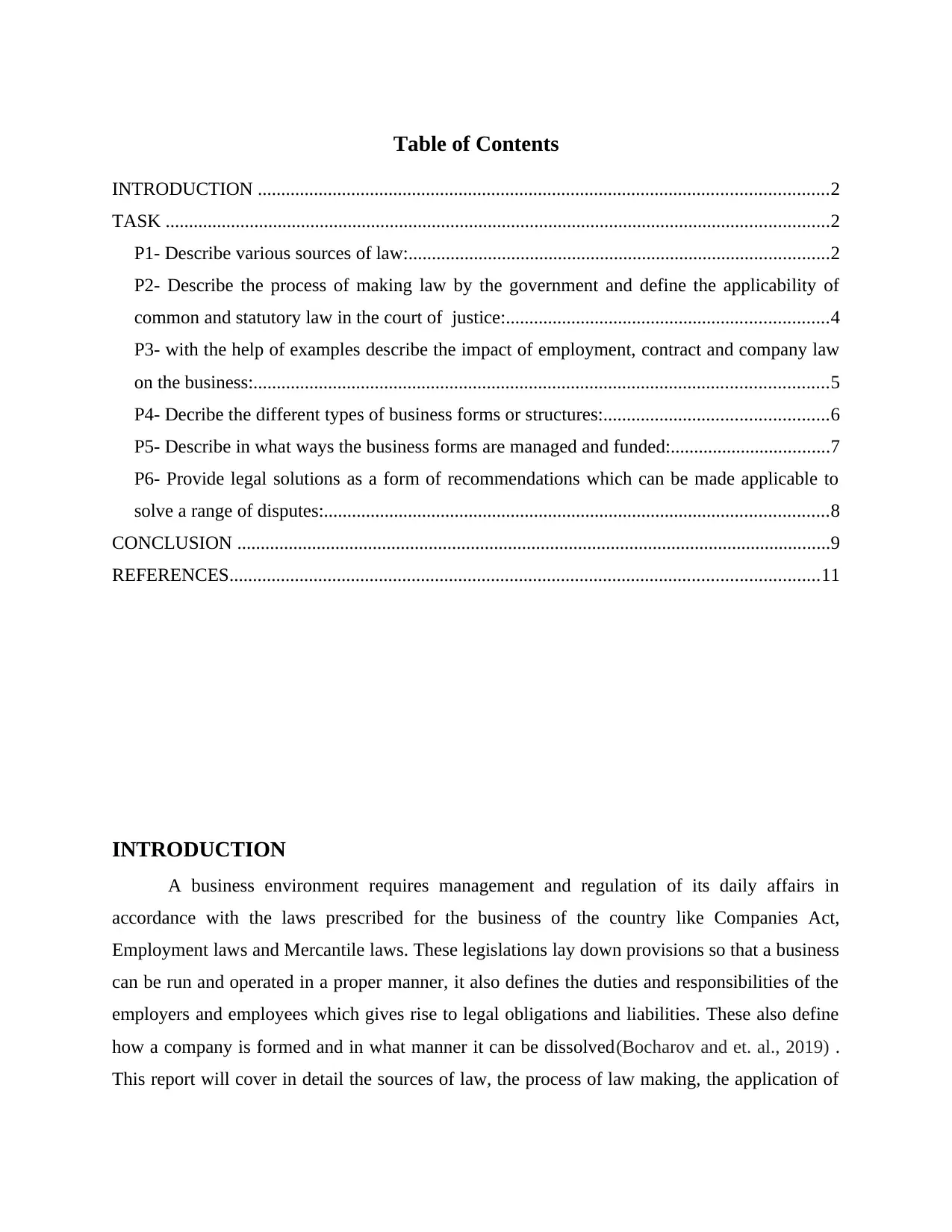
Table of Contents
INTRODUCTION ..........................................................................................................................2
TASK ..............................................................................................................................................2
P1- Describe various sources of law:..........................................................................................2
P2- Describe the process of making law by the government and define the applicability of
common and statutory law in the court of justice:.....................................................................4
P3- with the help of examples describe the impact of employment, contract and company law
on the business:...........................................................................................................................5
P4- Decribe the different types of business forms or structures:................................................6
P5- Describe in what ways the business forms are managed and funded:..................................7
P6- Provide legal solutions as a form of recommendations which can be made applicable to
solve a range of disputes:............................................................................................................8
CONCLUSION ...............................................................................................................................9
REFERENCES..............................................................................................................................11
INTRODUCTION
A business environment requires management and regulation of its daily affairs in
accordance with the laws prescribed for the business of the country like Companies Act,
Employment laws and Mercantile laws. These legislations lay down provisions so that a business
can be run and operated in a proper manner, it also defines the duties and responsibilities of the
employers and employees which gives rise to legal obligations and liabilities. These also define
how a company is formed and in what manner it can be dissolved(Bocharov and et. al., 2019) .
This report will cover in detail the sources of law, the process of law making, the application of
INTRODUCTION ..........................................................................................................................2
TASK ..............................................................................................................................................2
P1- Describe various sources of law:..........................................................................................2
P2- Describe the process of making law by the government and define the applicability of
common and statutory law in the court of justice:.....................................................................4
P3- with the help of examples describe the impact of employment, contract and company law
on the business:...........................................................................................................................5
P4- Decribe the different types of business forms or structures:................................................6
P5- Describe in what ways the business forms are managed and funded:..................................7
P6- Provide legal solutions as a form of recommendations which can be made applicable to
solve a range of disputes:............................................................................................................8
CONCLUSION ...............................................................................................................................9
REFERENCES..............................................................................................................................11
INTRODUCTION
A business environment requires management and regulation of its daily affairs in
accordance with the laws prescribed for the business of the country like Companies Act,
Employment laws and Mercantile laws. These legislations lay down provisions so that a business
can be run and operated in a proper manner, it also defines the duties and responsibilities of the
employers and employees which gives rise to legal obligations and liabilities. These also define
how a company is formed and in what manner it can be dissolved(Bocharov and et. al., 2019) .
This report will cover in detail the sources of law, the process of law making, the application of
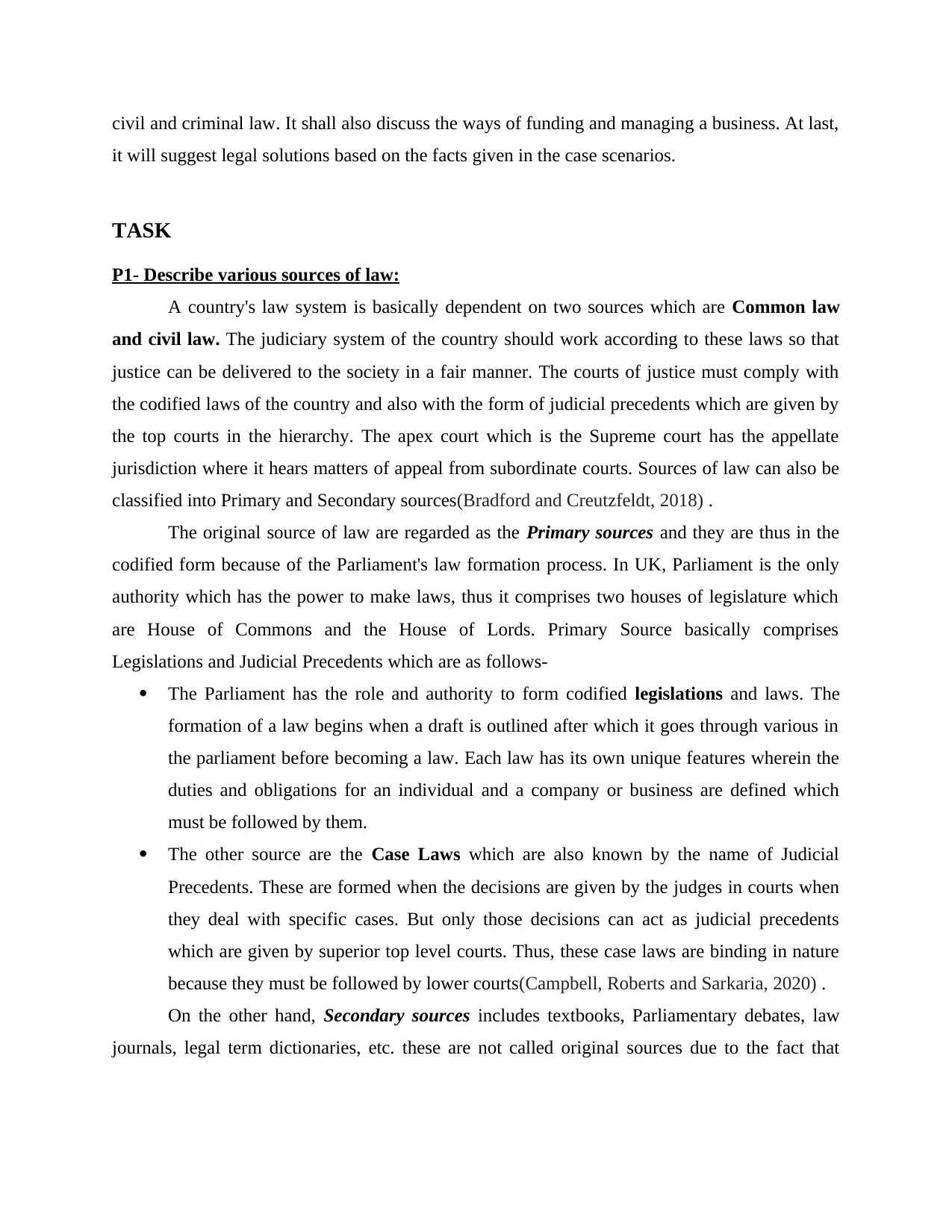
civil and criminal law. It shall also discuss the ways of funding and managing a business. At last,
it will suggest legal solutions based on the facts given in the case scenarios.
TASK
P1- Describe various sources of law:
A country's law system is basically dependent on two sources which are Common law
and civil law. The judiciary system of the country should work according to these laws so that
justice can be delivered to the society in a fair manner. The courts of justice must comply with
the codified laws of the country and also with the form of judicial precedents which are given by
the top courts in the hierarchy. The apex court which is the Supreme court has the appellate
jurisdiction where it hears matters of appeal from subordinate courts. Sources of law can also be
classified into Primary and Secondary sources(Bradford and Creutzfeldt, 2018) .
The original source of law are regarded as the Primary sources and they are thus in the
codified form because of the Parliament's law formation process. In UK, Parliament is the only
authority which has the power to make laws, thus it comprises two houses of legislature which
are House of Commons and the House of Lords. Primary Source basically comprises
Legislations and Judicial Precedents which are as follows-
The Parliament has the role and authority to form codified legislations and laws. The
formation of a law begins when a draft is outlined after which it goes through various in
the parliament before becoming a law. Each law has its own unique features wherein the
duties and obligations for an individual and a company or business are defined which
must be followed by them.
The other source are the Case Laws which are also known by the name of Judicial
Precedents. These are formed when the decisions are given by the judges in courts when
they deal with specific cases. But only those decisions can act as judicial precedents
which are given by superior top level courts. Thus, these case laws are binding in nature
because they must be followed by lower courts(Campbell, Roberts and Sarkaria, 2020) .
On the other hand, Secondary sources includes textbooks, Parliamentary debates, law
journals, legal term dictionaries, etc. these are not called original sources due to the fact that
it will suggest legal solutions based on the facts given in the case scenarios.
TASK
P1- Describe various sources of law:
A country's law system is basically dependent on two sources which are Common law
and civil law. The judiciary system of the country should work according to these laws so that
justice can be delivered to the society in a fair manner. The courts of justice must comply with
the codified laws of the country and also with the form of judicial precedents which are given by
the top courts in the hierarchy. The apex court which is the Supreme court has the appellate
jurisdiction where it hears matters of appeal from subordinate courts. Sources of law can also be
classified into Primary and Secondary sources(Bradford and Creutzfeldt, 2018) .
The original source of law are regarded as the Primary sources and they are thus in the
codified form because of the Parliament's law formation process. In UK, Parliament is the only
authority which has the power to make laws, thus it comprises two houses of legislature which
are House of Commons and the House of Lords. Primary Source basically comprises
Legislations and Judicial Precedents which are as follows-
The Parliament has the role and authority to form codified legislations and laws. The
formation of a law begins when a draft is outlined after which it goes through various in
the parliament before becoming a law. Each law has its own unique features wherein the
duties and obligations for an individual and a company or business are defined which
must be followed by them.
The other source are the Case Laws which are also known by the name of Judicial
Precedents. These are formed when the decisions are given by the judges in courts when
they deal with specific cases. But only those decisions can act as judicial precedents
which are given by superior top level courts. Thus, these case laws are binding in nature
because they must be followed by lower courts(Campbell, Roberts and Sarkaria, 2020) .
On the other hand, Secondary sources includes textbooks, Parliamentary debates, law
journals, legal term dictionaries, etc. these are not called original sources due to the fact that
⊘ This is a preview!⊘
Do you want full access?
Subscribe today to unlock all pages.

Trusted by 1+ million students worldwide
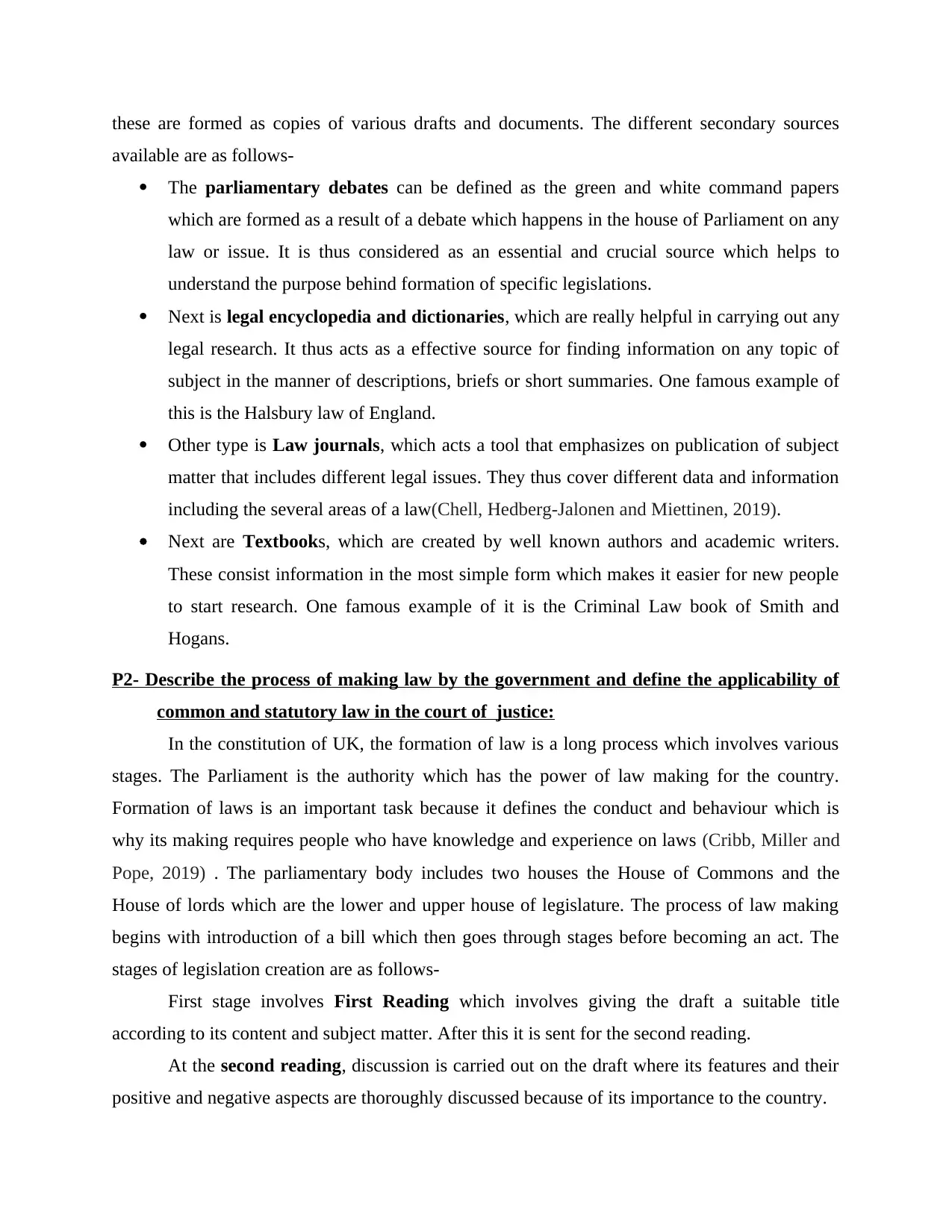
these are formed as copies of various drafts and documents. The different secondary sources
available are as follows-
The parliamentary debates can be defined as the green and white command papers
which are formed as a result of a debate which happens in the house of Parliament on any
law or issue. It is thus considered as an essential and crucial source which helps to
understand the purpose behind formation of specific legislations.
Next is legal encyclopedia and dictionaries, which are really helpful in carrying out any
legal research. It thus acts as a effective source for finding information on any topic of
subject in the manner of descriptions, briefs or short summaries. One famous example of
this is the Halsbury law of England.
Other type is Law journals, which acts a tool that emphasizes on publication of subject
matter that includes different legal issues. They thus cover different data and information
including the several areas of a law(Chell, Hedberg-Jalonen and Miettinen, 2019).
Next are Textbooks, which are created by well known authors and academic writers.
These consist information in the most simple form which makes it easier for new people
to start research. One famous example of it is the Criminal Law book of Smith and
Hogans.
P2- Describe the process of making law by the government and define the applicability of
common and statutory law in the court of justice:
In the constitution of UK, the formation of law is a long process which involves various
stages. The Parliament is the authority which has the power of law making for the country.
Formation of laws is an important task because it defines the conduct and behaviour which is
why its making requires people who have knowledge and experience on laws (Cribb, Miller and
Pope, 2019) . The parliamentary body includes two houses the House of Commons and the
House of lords which are the lower and upper house of legislature. The process of law making
begins with introduction of a bill which then goes through stages before becoming an act. The
stages of legislation creation are as follows-
First stage involves First Reading which involves giving the draft a suitable title
according to its content and subject matter. After this it is sent for the second reading.
At the second reading, discussion is carried out on the draft where its features and their
positive and negative aspects are thoroughly discussed because of its importance to the country.
available are as follows-
The parliamentary debates can be defined as the green and white command papers
which are formed as a result of a debate which happens in the house of Parliament on any
law or issue. It is thus considered as an essential and crucial source which helps to
understand the purpose behind formation of specific legislations.
Next is legal encyclopedia and dictionaries, which are really helpful in carrying out any
legal research. It thus acts as a effective source for finding information on any topic of
subject in the manner of descriptions, briefs or short summaries. One famous example of
this is the Halsbury law of England.
Other type is Law journals, which acts a tool that emphasizes on publication of subject
matter that includes different legal issues. They thus cover different data and information
including the several areas of a law(Chell, Hedberg-Jalonen and Miettinen, 2019).
Next are Textbooks, which are created by well known authors and academic writers.
These consist information in the most simple form which makes it easier for new people
to start research. One famous example of it is the Criminal Law book of Smith and
Hogans.
P2- Describe the process of making law by the government and define the applicability of
common and statutory law in the court of justice:
In the constitution of UK, the formation of law is a long process which involves various
stages. The Parliament is the authority which has the power of law making for the country.
Formation of laws is an important task because it defines the conduct and behaviour which is
why its making requires people who have knowledge and experience on laws (Cribb, Miller and
Pope, 2019) . The parliamentary body includes two houses the House of Commons and the
House of lords which are the lower and upper house of legislature. The process of law making
begins with introduction of a bill which then goes through stages before becoming an act. The
stages of legislation creation are as follows-
First stage involves First Reading which involves giving the draft a suitable title
according to its content and subject matter. After this it is sent for the second reading.
At the second reading, discussion is carried out on the draft where its features and their
positive and negative aspects are thoroughly discussed because of its importance to the country.
Paraphrase This Document
Need a fresh take? Get an instant paraphrase of this document with our AI Paraphraser
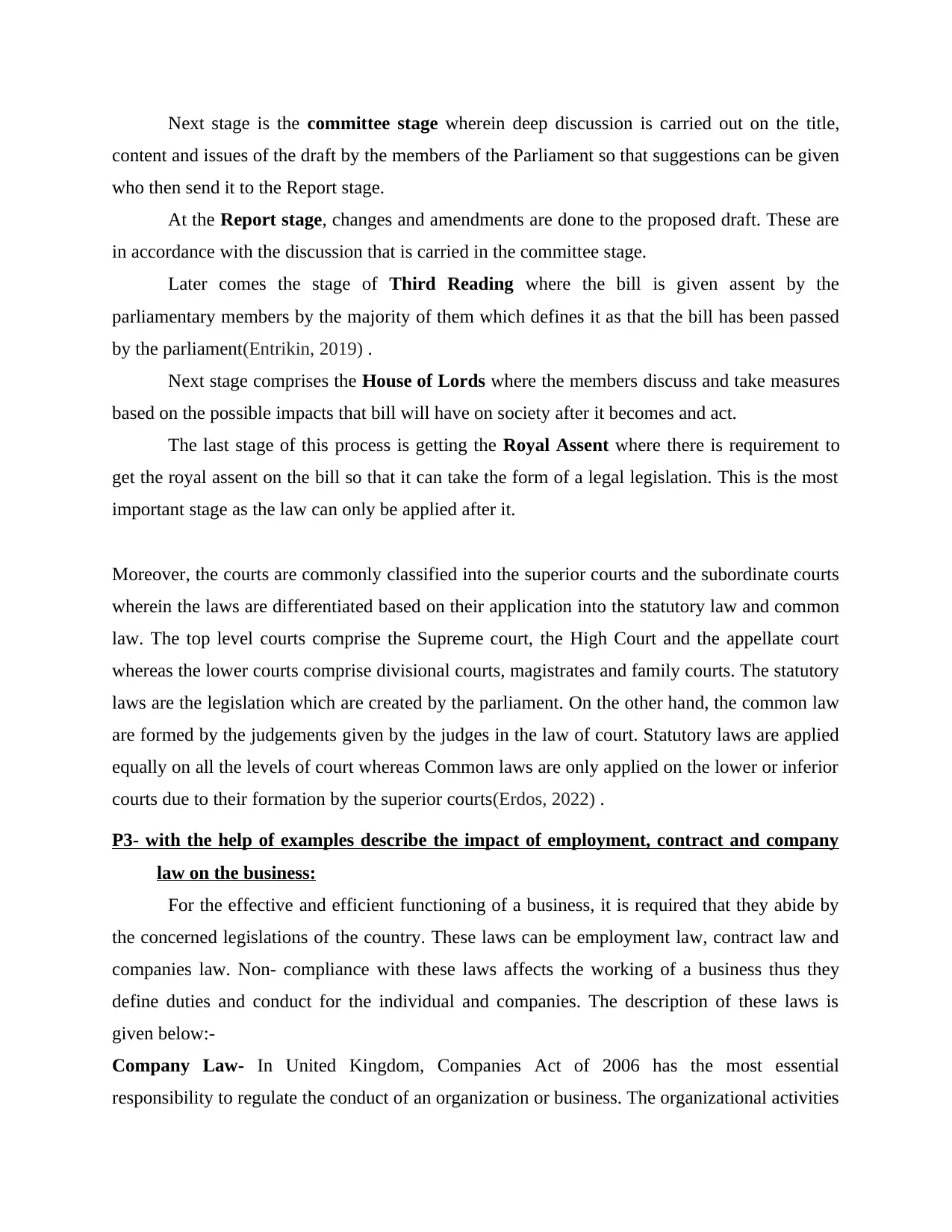
Next stage is the committee stage wherein deep discussion is carried out on the title,
content and issues of the draft by the members of the Parliament so that suggestions can be given
who then send it to the Report stage.
At the Report stage, changes and amendments are done to the proposed draft. These are
in accordance with the discussion that is carried in the committee stage.
Later comes the stage of Third Reading where the bill is given assent by the
parliamentary members by the majority of them which defines it as that the bill has been passed
by the parliament(Entrikin, 2019) .
Next stage comprises the House of Lords where the members discuss and take measures
based on the possible impacts that bill will have on society after it becomes and act.
The last stage of this process is getting the Royal Assent where there is requirement to
get the royal assent on the bill so that it can take the form of a legal legislation. This is the most
important stage as the law can only be applied after it.
Moreover, the courts are commonly classified into the superior courts and the subordinate courts
wherein the laws are differentiated based on their application into the statutory law and common
law. The top level courts comprise the Supreme court, the High Court and the appellate court
whereas the lower courts comprise divisional courts, magistrates and family courts. The statutory
laws are the legislation which are created by the parliament. On the other hand, the common law
are formed by the judgements given by the judges in the law of court. Statutory laws are applied
equally on all the levels of court whereas Common laws are only applied on the lower or inferior
courts due to their formation by the superior courts(Erdos, 2022) .
P3- with the help of examples describe the impact of employment, contract and company
law on the business:
For the effective and efficient functioning of a business, it is required that they abide by
the concerned legislations of the country. These laws can be employment law, contract law and
companies law. Non- compliance with these laws affects the working of a business thus they
define duties and conduct for the individual and companies. The description of these laws is
given below:-
Company Law- In United Kingdom, Companies Act of 2006 has the most essential
responsibility to regulate the conduct of an organization or business. The organizational activities
content and issues of the draft by the members of the Parliament so that suggestions can be given
who then send it to the Report stage.
At the Report stage, changes and amendments are done to the proposed draft. These are
in accordance with the discussion that is carried in the committee stage.
Later comes the stage of Third Reading where the bill is given assent by the
parliamentary members by the majority of them which defines it as that the bill has been passed
by the parliament(Entrikin, 2019) .
Next stage comprises the House of Lords where the members discuss and take measures
based on the possible impacts that bill will have on society after it becomes and act.
The last stage of this process is getting the Royal Assent where there is requirement to
get the royal assent on the bill so that it can take the form of a legal legislation. This is the most
important stage as the law can only be applied after it.
Moreover, the courts are commonly classified into the superior courts and the subordinate courts
wherein the laws are differentiated based on their application into the statutory law and common
law. The top level courts comprise the Supreme court, the High Court and the appellate court
whereas the lower courts comprise divisional courts, magistrates and family courts. The statutory
laws are the legislation which are created by the parliament. On the other hand, the common law
are formed by the judgements given by the judges in the law of court. Statutory laws are applied
equally on all the levels of court whereas Common laws are only applied on the lower or inferior
courts due to their formation by the superior courts(Erdos, 2022) .
P3- with the help of examples describe the impact of employment, contract and company
law on the business:
For the effective and efficient functioning of a business, it is required that they abide by
the concerned legislations of the country. These laws can be employment law, contract law and
companies law. Non- compliance with these laws affects the working of a business thus they
define duties and conduct for the individual and companies. The description of these laws is
given below:-
Company Law- In United Kingdom, Companies Act of 2006 has the most essential
responsibility to regulate the conduct of an organization or business. The organizational activities
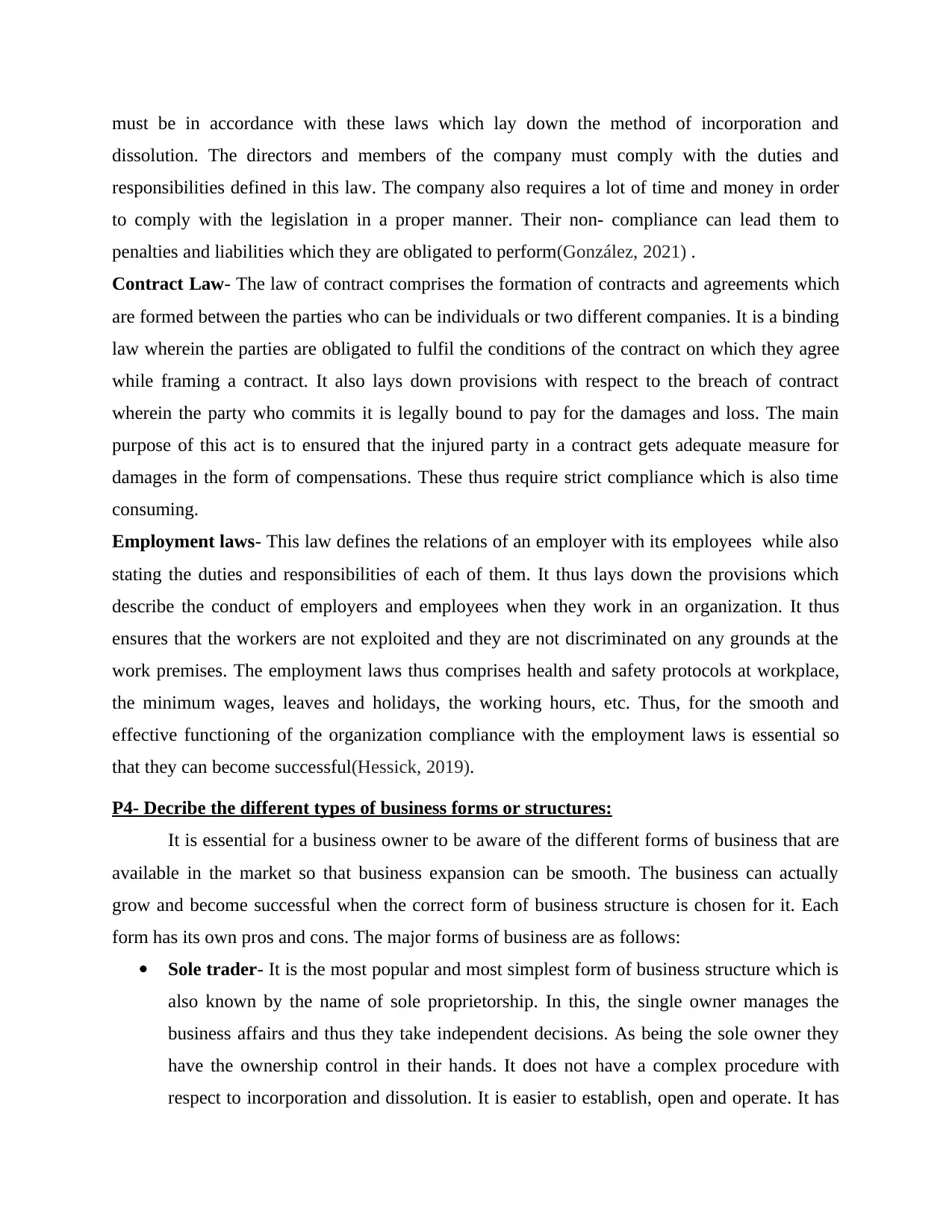
must be in accordance with these laws which lay down the method of incorporation and
dissolution. The directors and members of the company must comply with the duties and
responsibilities defined in this law. The company also requires a lot of time and money in order
to comply with the legislation in a proper manner. Their non- compliance can lead them to
penalties and liabilities which they are obligated to perform(González, 2021) .
Contract Law- The law of contract comprises the formation of contracts and agreements which
are formed between the parties who can be individuals or two different companies. It is a binding
law wherein the parties are obligated to fulfil the conditions of the contract on which they agree
while framing a contract. It also lays down provisions with respect to the breach of contract
wherein the party who commits it is legally bound to pay for the damages and loss. The main
purpose of this act is to ensured that the injured party in a contract gets adequate measure for
damages in the form of compensations. These thus require strict compliance which is also time
consuming.
Employment laws- This law defines the relations of an employer with its employees while also
stating the duties and responsibilities of each of them. It thus lays down the provisions which
describe the conduct of employers and employees when they work in an organization. It thus
ensures that the workers are not exploited and they are not discriminated on any grounds at the
work premises. The employment laws thus comprises health and safety protocols at workplace,
the minimum wages, leaves and holidays, the working hours, etc. Thus, for the smooth and
effective functioning of the organization compliance with the employment laws is essential so
that they can become successful(Hessick, 2019).
P4- Decribe the different types of business forms or structures:
It is essential for a business owner to be aware of the different forms of business that are
available in the market so that business expansion can be smooth. The business can actually
grow and become successful when the correct form of business structure is chosen for it. Each
form has its own pros and cons. The major forms of business are as follows:
Sole trader- It is the most popular and most simplest form of business structure which is
also known by the name of sole proprietorship. In this, the single owner manages the
business affairs and thus they take independent decisions. As being the sole owner they
have the ownership control in their hands. It does not have a complex procedure with
respect to incorporation and dissolution. It is easier to establish, open and operate. It has
dissolution. The directors and members of the company must comply with the duties and
responsibilities defined in this law. The company also requires a lot of time and money in order
to comply with the legislation in a proper manner. Their non- compliance can lead them to
penalties and liabilities which they are obligated to perform(González, 2021) .
Contract Law- The law of contract comprises the formation of contracts and agreements which
are formed between the parties who can be individuals or two different companies. It is a binding
law wherein the parties are obligated to fulfil the conditions of the contract on which they agree
while framing a contract. It also lays down provisions with respect to the breach of contract
wherein the party who commits it is legally bound to pay for the damages and loss. The main
purpose of this act is to ensured that the injured party in a contract gets adequate measure for
damages in the form of compensations. These thus require strict compliance which is also time
consuming.
Employment laws- This law defines the relations of an employer with its employees while also
stating the duties and responsibilities of each of them. It thus lays down the provisions which
describe the conduct of employers and employees when they work in an organization. It thus
ensures that the workers are not exploited and they are not discriminated on any grounds at the
work premises. The employment laws thus comprises health and safety protocols at workplace,
the minimum wages, leaves and holidays, the working hours, etc. Thus, for the smooth and
effective functioning of the organization compliance with the employment laws is essential so
that they can become successful(Hessick, 2019).
P4- Decribe the different types of business forms or structures:
It is essential for a business owner to be aware of the different forms of business that are
available in the market so that business expansion can be smooth. The business can actually
grow and become successful when the correct form of business structure is chosen for it. Each
form has its own pros and cons. The major forms of business are as follows:
Sole trader- It is the most popular and most simplest form of business structure which is
also known by the name of sole proprietorship. In this, the single owner manages the
business affairs and thus they take independent decisions. As being the sole owner they
have the ownership control in their hands. It does not have a complex procedure with
respect to incorporation and dissolution. It is easier to establish, open and operate. It has
⊘ This is a preview!⊘
Do you want full access?
Subscribe today to unlock all pages.

Trusted by 1+ million students worldwide
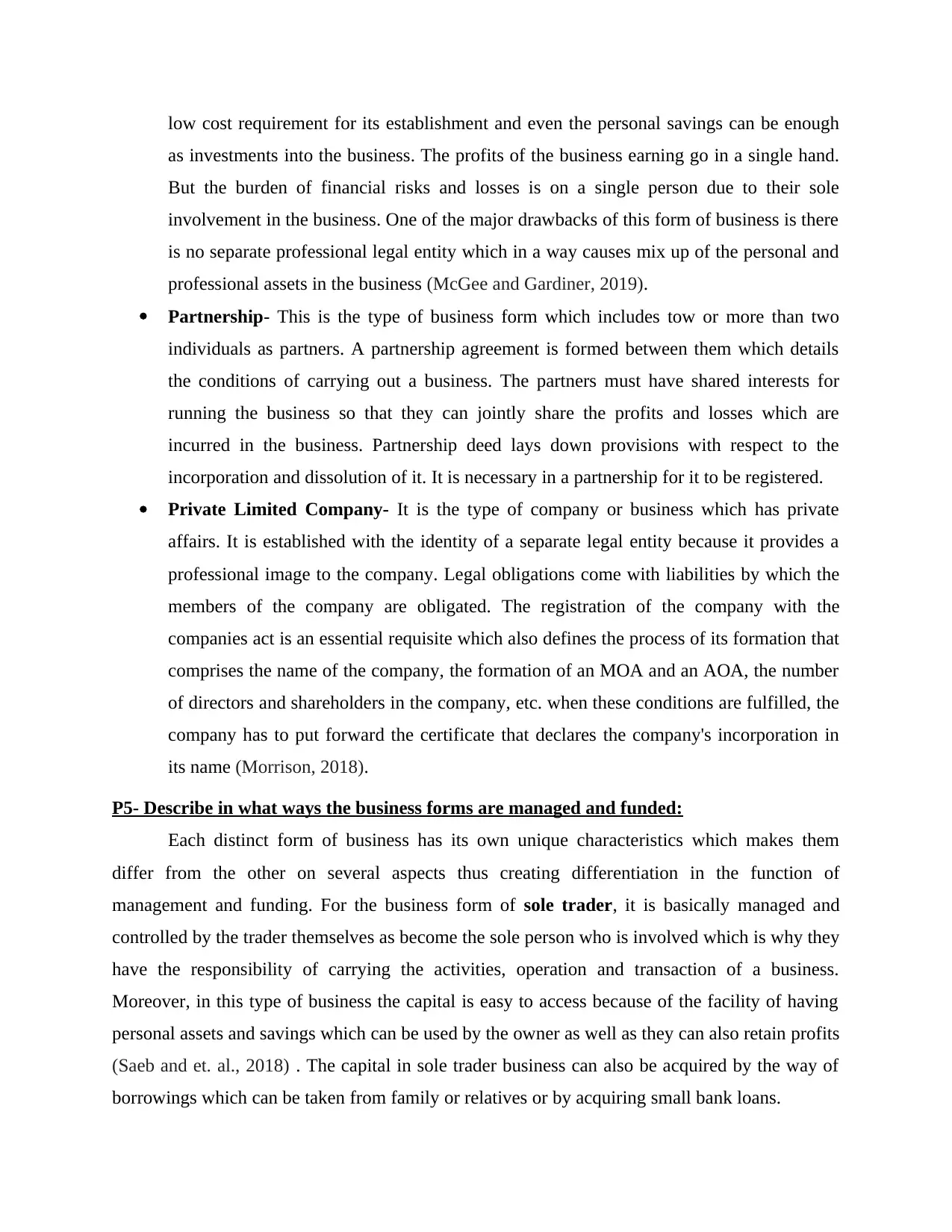
low cost requirement for its establishment and even the personal savings can be enough
as investments into the business. The profits of the business earning go in a single hand.
But the burden of financial risks and losses is on a single person due to their sole
involvement in the business. One of the major drawbacks of this form of business is there
is no separate professional legal entity which in a way causes mix up of the personal and
professional assets in the business (McGee and Gardiner, 2019).
Partnership- This is the type of business form which includes tow or more than two
individuals as partners. A partnership agreement is formed between them which details
the conditions of carrying out a business. The partners must have shared interests for
running the business so that they can jointly share the profits and losses which are
incurred in the business. Partnership deed lays down provisions with respect to the
incorporation and dissolution of it. It is necessary in a partnership for it to be registered.
Private Limited Company- It is the type of company or business which has private
affairs. It is established with the identity of a separate legal entity because it provides a
professional image to the company. Legal obligations come with liabilities by which the
members of the company are obligated. The registration of the company with the
companies act is an essential requisite which also defines the process of its formation that
comprises the name of the company, the formation of an MOA and an AOA, the number
of directors and shareholders in the company, etc. when these conditions are fulfilled, the
company has to put forward the certificate that declares the company's incorporation in
its name (Morrison, 2018).
P5- Describe in what ways the business forms are managed and funded:
Each distinct form of business has its own unique characteristics which makes them
differ from the other on several aspects thus creating differentiation in the function of
management and funding. For the business form of sole trader, it is basically managed and
controlled by the trader themselves as become the sole person who is involved which is why they
have the responsibility of carrying the activities, operation and transaction of a business.
Moreover, in this type of business the capital is easy to access because of the facility of having
personal assets and savings which can be used by the owner as well as they can also retain profits
(Saeb and et. al., 2018) . The capital in sole trader business can also be acquired by the way of
borrowings which can be taken from family or relatives or by acquiring small bank loans.
as investments into the business. The profits of the business earning go in a single hand.
But the burden of financial risks and losses is on a single person due to their sole
involvement in the business. One of the major drawbacks of this form of business is there
is no separate professional legal entity which in a way causes mix up of the personal and
professional assets in the business (McGee and Gardiner, 2019).
Partnership- This is the type of business form which includes tow or more than two
individuals as partners. A partnership agreement is formed between them which details
the conditions of carrying out a business. The partners must have shared interests for
running the business so that they can jointly share the profits and losses which are
incurred in the business. Partnership deed lays down provisions with respect to the
incorporation and dissolution of it. It is necessary in a partnership for it to be registered.
Private Limited Company- It is the type of company or business which has private
affairs. It is established with the identity of a separate legal entity because it provides a
professional image to the company. Legal obligations come with liabilities by which the
members of the company are obligated. The registration of the company with the
companies act is an essential requisite which also defines the process of its formation that
comprises the name of the company, the formation of an MOA and an AOA, the number
of directors and shareholders in the company, etc. when these conditions are fulfilled, the
company has to put forward the certificate that declares the company's incorporation in
its name (Morrison, 2018).
P5- Describe in what ways the business forms are managed and funded:
Each distinct form of business has its own unique characteristics which makes them
differ from the other on several aspects thus creating differentiation in the function of
management and funding. For the business form of sole trader, it is basically managed and
controlled by the trader themselves as become the sole person who is involved which is why they
have the responsibility of carrying the activities, operation and transaction of a business.
Moreover, in this type of business the capital is easy to access because of the facility of having
personal assets and savings which can be used by the owner as well as they can also retain profits
(Saeb and et. al., 2018) . The capital in sole trader business can also be acquired by the way of
borrowings which can be taken from family or relatives or by acquiring small bank loans.
Paraphrase This Document
Need a fresh take? Get an instant paraphrase of this document with our AI Paraphraser
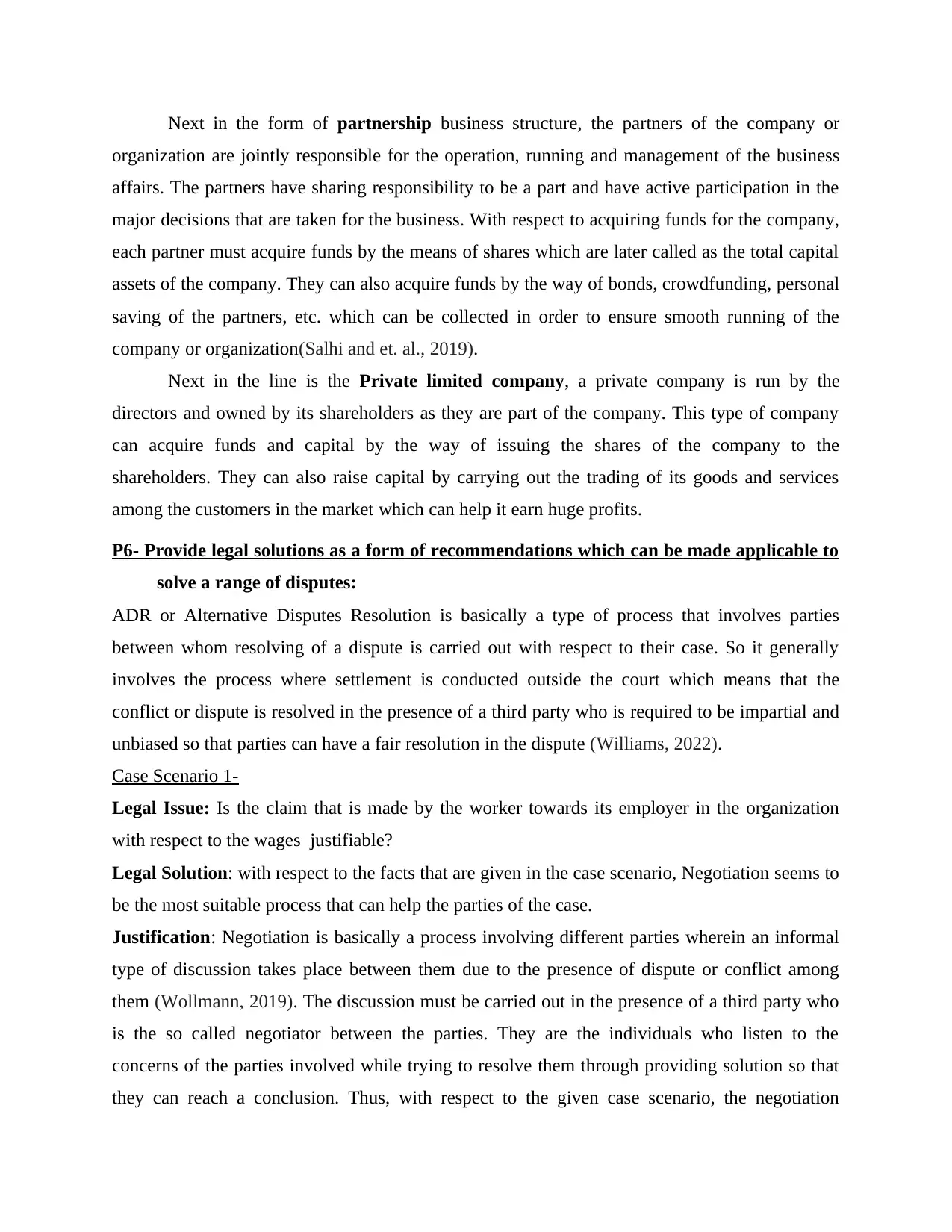
Next in the form of partnership business structure, the partners of the company or
organization are jointly responsible for the operation, running and management of the business
affairs. The partners have sharing responsibility to be a part and have active participation in the
major decisions that are taken for the business. With respect to acquiring funds for the company,
each partner must acquire funds by the means of shares which are later called as the total capital
assets of the company. They can also acquire funds by the way of bonds, crowdfunding, personal
saving of the partners, etc. which can be collected in order to ensure smooth running of the
company or organization(Salhi and et. al., 2019).
Next in the line is the Private limited company, a private company is run by the
directors and owned by its shareholders as they are part of the company. This type of company
can acquire funds and capital by the way of issuing the shares of the company to the
shareholders. They can also raise capital by carrying out the trading of its goods and services
among the customers in the market which can help it earn huge profits.
P6- Provide legal solutions as a form of recommendations which can be made applicable to
solve a range of disputes:
ADR or Alternative Disputes Resolution is basically a type of process that involves parties
between whom resolving of a dispute is carried out with respect to their case. So it generally
involves the process where settlement is conducted outside the court which means that the
conflict or dispute is resolved in the presence of a third party who is required to be impartial and
unbiased so that parties can have a fair resolution in the dispute (Williams, 2022).
Case Scenario 1-
Legal Issue: Is the claim that is made by the worker towards its employer in the organization
with respect to the wages justifiable?
Legal Solution: with respect to the facts that are given in the case scenario, Negotiation seems to
be the most suitable process that can help the parties of the case.
Justification: Negotiation is basically a process involving different parties wherein an informal
type of discussion takes place between them due to the presence of dispute or conflict among
them (Wollmann, 2019). The discussion must be carried out in the presence of a third party who
is the so called negotiator between the parties. They are the individuals who listen to the
concerns of the parties involved while trying to resolve them through providing solution so that
they can reach a conclusion. Thus, with respect to the given case scenario, the negotiation
organization are jointly responsible for the operation, running and management of the business
affairs. The partners have sharing responsibility to be a part and have active participation in the
major decisions that are taken for the business. With respect to acquiring funds for the company,
each partner must acquire funds by the means of shares which are later called as the total capital
assets of the company. They can also acquire funds by the way of bonds, crowdfunding, personal
saving of the partners, etc. which can be collected in order to ensure smooth running of the
company or organization(Salhi and et. al., 2019).
Next in the line is the Private limited company, a private company is run by the
directors and owned by its shareholders as they are part of the company. This type of company
can acquire funds and capital by the way of issuing the shares of the company to the
shareholders. They can also raise capital by carrying out the trading of its goods and services
among the customers in the market which can help it earn huge profits.
P6- Provide legal solutions as a form of recommendations which can be made applicable to
solve a range of disputes:
ADR or Alternative Disputes Resolution is basically a type of process that involves parties
between whom resolving of a dispute is carried out with respect to their case. So it generally
involves the process where settlement is conducted outside the court which means that the
conflict or dispute is resolved in the presence of a third party who is required to be impartial and
unbiased so that parties can have a fair resolution in the dispute (Williams, 2022).
Case Scenario 1-
Legal Issue: Is the claim that is made by the worker towards its employer in the organization
with respect to the wages justifiable?
Legal Solution: with respect to the facts that are given in the case scenario, Negotiation seems to
be the most suitable process that can help the parties of the case.
Justification: Negotiation is basically a process involving different parties wherein an informal
type of discussion takes place between them due to the presence of dispute or conflict among
them (Wollmann, 2019). The discussion must be carried out in the presence of a third party who
is the so called negotiator between the parties. They are the individuals who listen to the
concerns of the parties involved while trying to resolve them through providing solution so that
they can reach a conclusion. Thus, with respect to the given case scenario, the negotiation
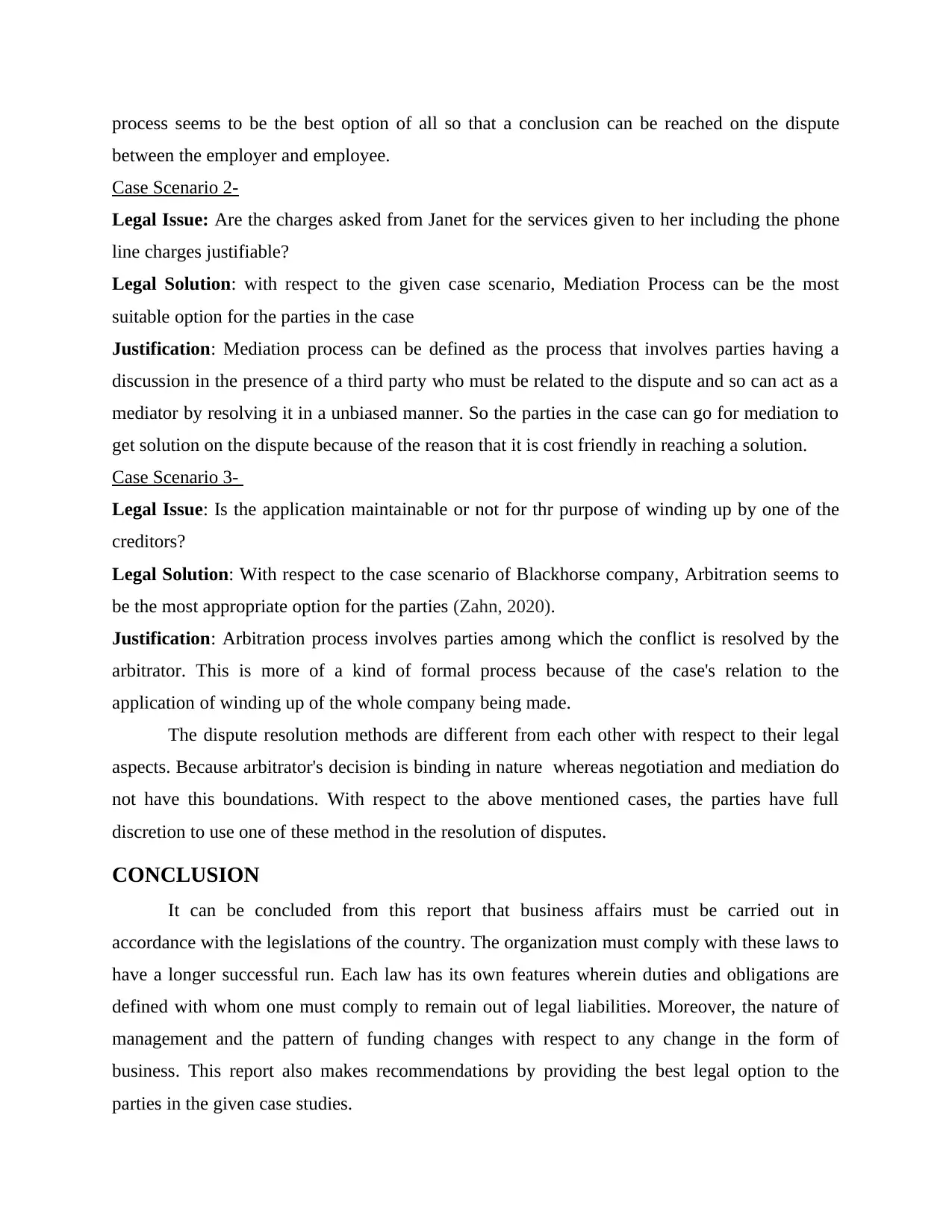
process seems to be the best option of all so that a conclusion can be reached on the dispute
between the employer and employee.
Case Scenario 2-
Legal Issue: Are the charges asked from Janet for the services given to her including the phone
line charges justifiable?
Legal Solution: with respect to the given case scenario, Mediation Process can be the most
suitable option for the parties in the case
Justification: Mediation process can be defined as the process that involves parties having a
discussion in the presence of a third party who must be related to the dispute and so can act as a
mediator by resolving it in a unbiased manner. So the parties in the case can go for mediation to
get solution on the dispute because of the reason that it is cost friendly in reaching a solution.
Case Scenario 3-
Legal Issue: Is the application maintainable or not for thr purpose of winding up by one of the
creditors?
Legal Solution: With respect to the case scenario of Blackhorse company, Arbitration seems to
be the most appropriate option for the parties (Zahn, 2020).
Justification: Arbitration process involves parties among which the conflict is resolved by the
arbitrator. This is more of a kind of formal process because of the case's relation to the
application of winding up of the whole company being made.
The dispute resolution methods are different from each other with respect to their legal
aspects. Because arbitrator's decision is binding in nature whereas negotiation and mediation do
not have this boundations. With respect to the above mentioned cases, the parties have full
discretion to use one of these method in the resolution of disputes.
CONCLUSION
It can be concluded from this report that business affairs must be carried out in
accordance with the legislations of the country. The organization must comply with these laws to
have a longer successful run. Each law has its own features wherein duties and obligations are
defined with whom one must comply to remain out of legal liabilities. Moreover, the nature of
management and the pattern of funding changes with respect to any change in the form of
business. This report also makes recommendations by providing the best legal option to the
parties in the given case studies.
between the employer and employee.
Case Scenario 2-
Legal Issue: Are the charges asked from Janet for the services given to her including the phone
line charges justifiable?
Legal Solution: with respect to the given case scenario, Mediation Process can be the most
suitable option for the parties in the case
Justification: Mediation process can be defined as the process that involves parties having a
discussion in the presence of a third party who must be related to the dispute and so can act as a
mediator by resolving it in a unbiased manner. So the parties in the case can go for mediation to
get solution on the dispute because of the reason that it is cost friendly in reaching a solution.
Case Scenario 3-
Legal Issue: Is the application maintainable or not for thr purpose of winding up by one of the
creditors?
Legal Solution: With respect to the case scenario of Blackhorse company, Arbitration seems to
be the most appropriate option for the parties (Zahn, 2020).
Justification: Arbitration process involves parties among which the conflict is resolved by the
arbitrator. This is more of a kind of formal process because of the case's relation to the
application of winding up of the whole company being made.
The dispute resolution methods are different from each other with respect to their legal
aspects. Because arbitrator's decision is binding in nature whereas negotiation and mediation do
not have this boundations. With respect to the above mentioned cases, the parties have full
discretion to use one of these method in the resolution of disputes.
CONCLUSION
It can be concluded from this report that business affairs must be carried out in
accordance with the legislations of the country. The organization must comply with these laws to
have a longer successful run. Each law has its own features wherein duties and obligations are
defined with whom one must comply to remain out of legal liabilities. Moreover, the nature of
management and the pattern of funding changes with respect to any change in the form of
business. This report also makes recommendations by providing the best legal option to the
parties in the given case studies.
⊘ This is a preview!⊘
Do you want full access?
Subscribe today to unlock all pages.

Trusted by 1+ million students worldwide
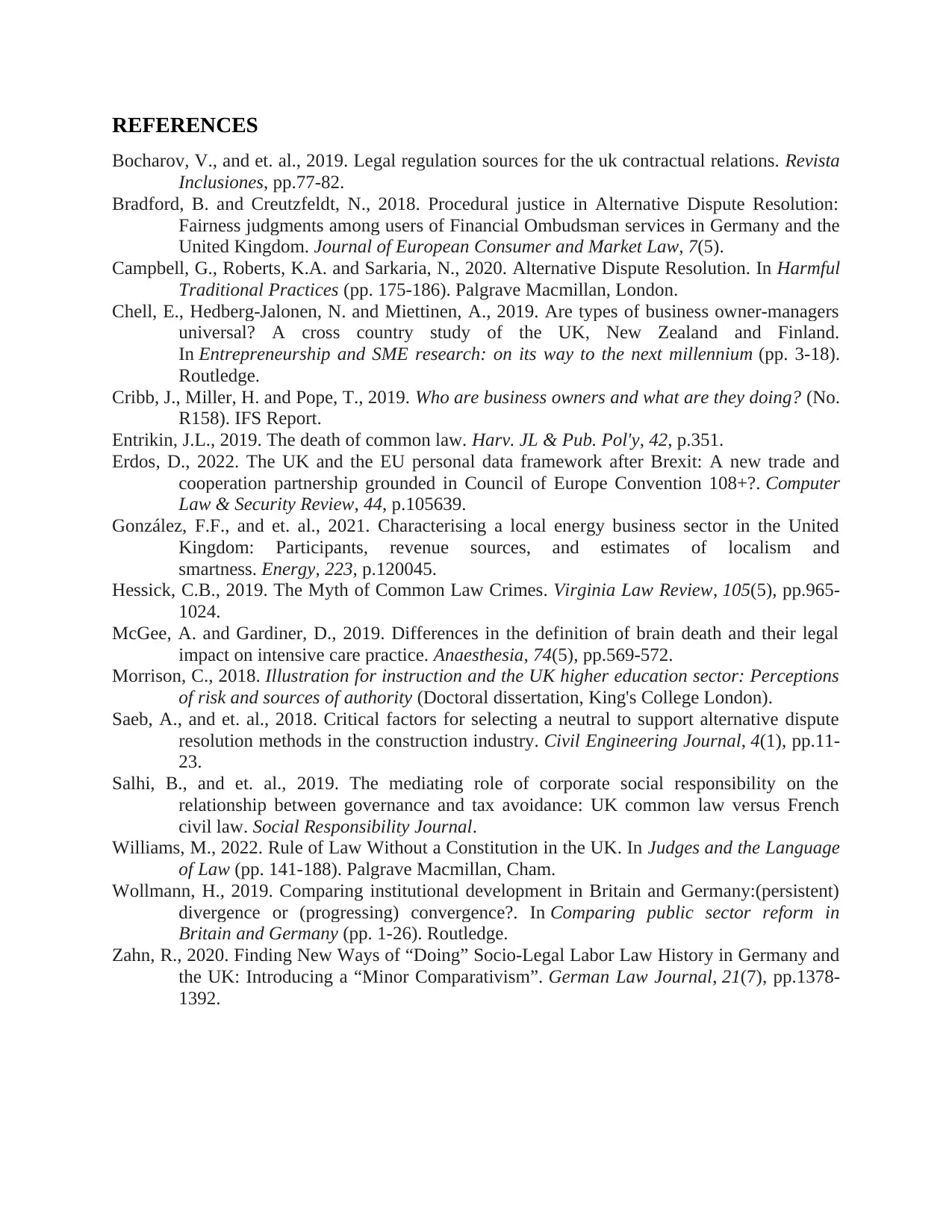
REFERENCES
Bocharov, V., and et. al., 2019. Legal regulation sources for the uk contractual relations. Revista
Inclusiones, pp.77-82.
Bradford, B. and Creutzfeldt, N., 2018. Procedural justice in Alternative Dispute Resolution:
Fairness judgments among users of Financial Ombudsman services in Germany and the
United Kingdom. Journal of European Consumer and Market Law, 7(5).
Campbell, G., Roberts, K.A. and Sarkaria, N., 2020. Alternative Dispute Resolution. In Harmful
Traditional Practices (pp. 175-186). Palgrave Macmillan, London.
Chell, E., Hedberg-Jalonen, N. and Miettinen, A., 2019. Are types of business owner-managers
universal? A cross country study of the UK, New Zealand and Finland.
In Entrepreneurship and SME research: on its way to the next millennium (pp. 3-18).
Routledge.
Cribb, J., Miller, H. and Pope, T., 2019. Who are business owners and what are they doing? (No.
R158). IFS Report.
Entrikin, J.L., 2019. The death of common law. Harv. JL & Pub. Pol'y, 42, p.351.
Erdos, D., 2022. The UK and the EU personal data framework after Brexit: A new trade and
cooperation partnership grounded in Council of Europe Convention 108+?. Computer
Law & Security Review, 44, p.105639.
González, F.F., and et. al., 2021. Characterising a local energy business sector in the United
Kingdom: Participants, revenue sources, and estimates of localism and
smartness. Energy, 223, p.120045.
Hessick, C.B., 2019. The Myth of Common Law Crimes. Virginia Law Review, 105(5), pp.965-
1024.
McGee, A. and Gardiner, D., 2019. Differences in the definition of brain death and their legal
impact on intensive care practice. Anaesthesia, 74(5), pp.569-572.
Morrison, C., 2018. Illustration for instruction and the UK higher education sector: Perceptions
of risk and sources of authority (Doctoral dissertation, King's College London).
Saeb, A., and et. al., 2018. Critical factors for selecting a neutral to support alternative dispute
resolution methods in the construction industry. Civil Engineering Journal, 4(1), pp.11-
23.
Salhi, B., and et. al., 2019. The mediating role of corporate social responsibility on the
relationship between governance and tax avoidance: UK common law versus French
civil law. Social Responsibility Journal.
Williams, M., 2022. Rule of Law Without a Constitution in the UK. In Judges and the Language
of Law (pp. 141-188). Palgrave Macmillan, Cham.
Wollmann, H., 2019. Comparing institutional development in Britain and Germany:(persistent)
divergence or (progressing) convergence?. In Comparing public sector reform in
Britain and Germany (pp. 1-26). Routledge.
Zahn, R., 2020. Finding New Ways of “Doing” Socio-Legal Labor Law History in Germany and
the UK: Introducing a “Minor Comparativism”. German Law Journal, 21(7), pp.1378-
1392.
Bocharov, V., and et. al., 2019. Legal regulation sources for the uk contractual relations. Revista
Inclusiones, pp.77-82.
Bradford, B. and Creutzfeldt, N., 2018. Procedural justice in Alternative Dispute Resolution:
Fairness judgments among users of Financial Ombudsman services in Germany and the
United Kingdom. Journal of European Consumer and Market Law, 7(5).
Campbell, G., Roberts, K.A. and Sarkaria, N., 2020. Alternative Dispute Resolution. In Harmful
Traditional Practices (pp. 175-186). Palgrave Macmillan, London.
Chell, E., Hedberg-Jalonen, N. and Miettinen, A., 2019. Are types of business owner-managers
universal? A cross country study of the UK, New Zealand and Finland.
In Entrepreneurship and SME research: on its way to the next millennium (pp. 3-18).
Routledge.
Cribb, J., Miller, H. and Pope, T., 2019. Who are business owners and what are they doing? (No.
R158). IFS Report.
Entrikin, J.L., 2019. The death of common law. Harv. JL & Pub. Pol'y, 42, p.351.
Erdos, D., 2022. The UK and the EU personal data framework after Brexit: A new trade and
cooperation partnership grounded in Council of Europe Convention 108+?. Computer
Law & Security Review, 44, p.105639.
González, F.F., and et. al., 2021. Characterising a local energy business sector in the United
Kingdom: Participants, revenue sources, and estimates of localism and
smartness. Energy, 223, p.120045.
Hessick, C.B., 2019. The Myth of Common Law Crimes. Virginia Law Review, 105(5), pp.965-
1024.
McGee, A. and Gardiner, D., 2019. Differences in the definition of brain death and their legal
impact on intensive care practice. Anaesthesia, 74(5), pp.569-572.
Morrison, C., 2018. Illustration for instruction and the UK higher education sector: Perceptions
of risk and sources of authority (Doctoral dissertation, King's College London).
Saeb, A., and et. al., 2018. Critical factors for selecting a neutral to support alternative dispute
resolution methods in the construction industry. Civil Engineering Journal, 4(1), pp.11-
23.
Salhi, B., and et. al., 2019. The mediating role of corporate social responsibility on the
relationship between governance and tax avoidance: UK common law versus French
civil law. Social Responsibility Journal.
Williams, M., 2022. Rule of Law Without a Constitution in the UK. In Judges and the Language
of Law (pp. 141-188). Palgrave Macmillan, Cham.
Wollmann, H., 2019. Comparing institutional development in Britain and Germany:(persistent)
divergence or (progressing) convergence?. In Comparing public sector reform in
Britain and Germany (pp. 1-26). Routledge.
Zahn, R., 2020. Finding New Ways of “Doing” Socio-Legal Labor Law History in Germany and
the UK: Introducing a “Minor Comparativism”. German Law Journal, 21(7), pp.1378-
1392.
1 out of 10
Related Documents
Your All-in-One AI-Powered Toolkit for Academic Success.
+13062052269
info@desklib.com
Available 24*7 on WhatsApp / Email
![[object Object]](/_next/static/media/star-bottom.7253800d.svg)
Unlock your academic potential
Copyright © 2020–2025 A2Z Services. All Rights Reserved. Developed and managed by ZUCOL.



